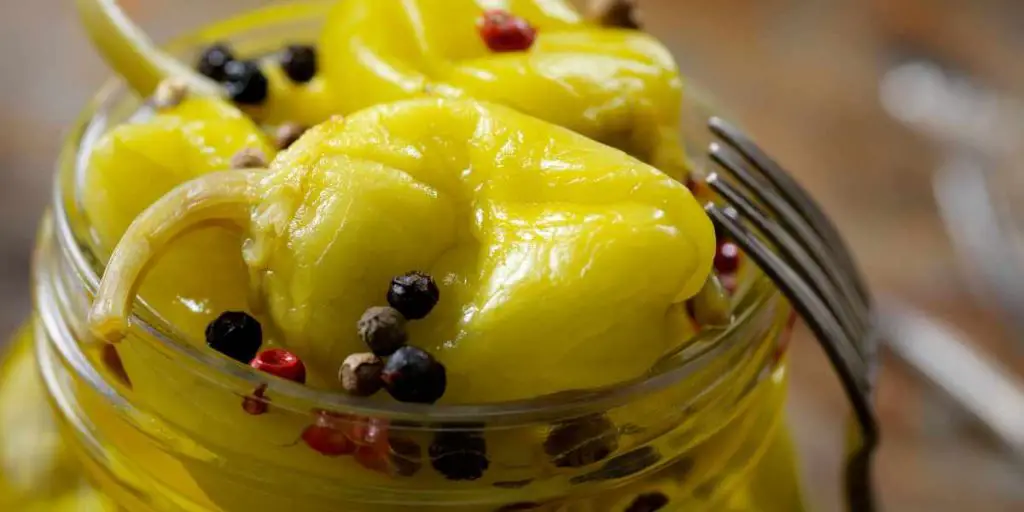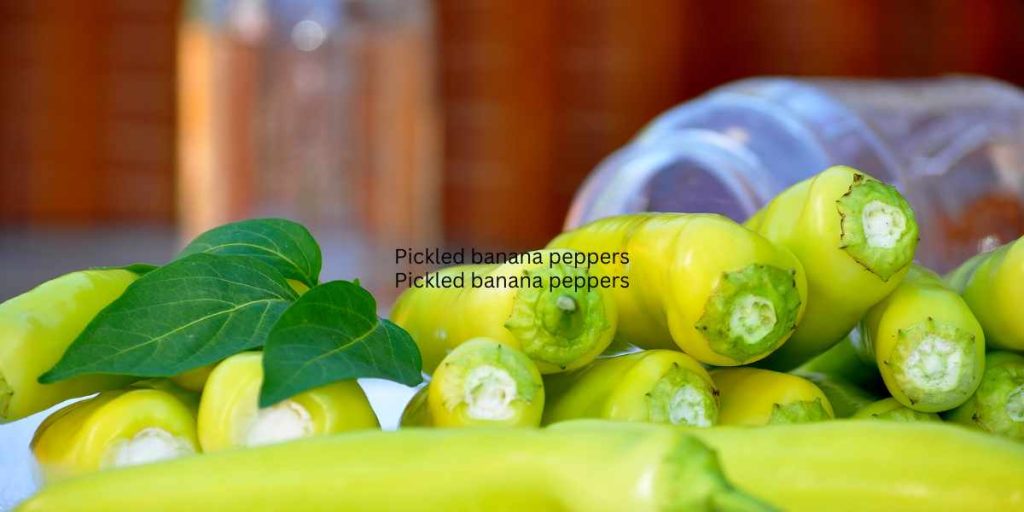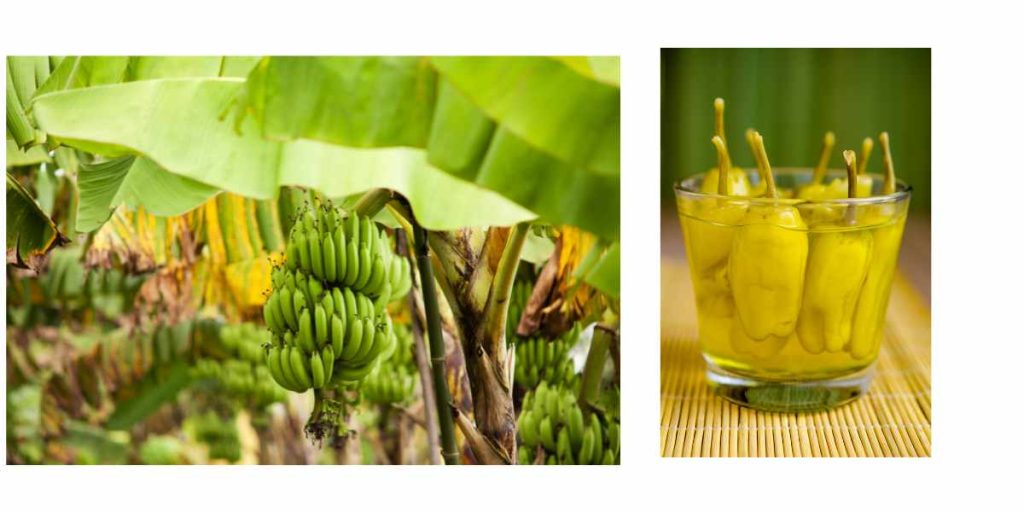Banana peppers vs pepperoncini
Banana peppers and pepperoncini are two popular types of peppers that are often confused with each other. While they may look similar, they have distinct differences in terms of appearance, flavor, heat level, and nutritional value.
In this blog post, we will explore the differences between banana peppers vs pepperoncini and provide information on how to use them in cooking and preserving.
What are banana peppers?
First, let’s take a look at banana peppers. Banana peppers, also known as yellow wax peppers, are a popular variety of pepper that are easy to grow. They are typically 4-6 inches long and have a bright yellow or orange color.
They have a sweet and mild flavor, with just a slight hint of heat. In terms of nutritional value, one cup of banana peppers contains approximately 24 grams of carbohydrates, 2 grams of protein, and 0 grams of fat. They are a good source of vitamin C and vitamin K.
What are pepperoncini?

Next, let’s take a look at pepperoncini. Pepperoncini, also known as Tuscan peppers, is a variety of chili pepper that is popular in Mediterranean cuisine. They are typically 2-3 inches long and have a bright green color.
They have a mild, slightly sweet, and tangy flavor with a moderate level of heat. In terms of nutritional value, one cup of pepperoncini contains approximately 5 grams of carbohydrates, 1 gram of protein, and 0 grams of fat. They are a good source of vitamin C and vitamin A.
Differences between banana peppers and pepperoncini
The biggest difference between banana peppers and pepperoncini is their flavor and heat level. Banana peppers have a sweeter and milder flavor, while pepperoncini have a tangy and slightly sweet flavor with a moderate level of heat.
This means that banana peppers are more suitable for people who prefer a milder taste, while pepperoncini are more suitable for those who prefer a slightly spicier taste.
In terms of appearance, banana peppers are typically larger and have a bright yellow or orange color, while pepperoncini are smaller and have a bright green color. The size and color can also be an indicator of maturity and ripeness.
When it comes to cooking and preserving, both banana peppers and pepperoncini can be used in a variety of ways. Both can be eaten fresh, pickled, canned, or roasted.
Banana peppers can also be used in sauces or as a topping for sandwiches and pizzas. Pepperoncini can also be used in sandwiches and pizzas or added to salads for a tangy and slightly spicy flavor.
frequently asked question
Pickled banana peppers vs pepperoncini

Pickling is a popular way to preserve peppers, and both banana peppers and pepperoncini can be pickled to enjoy all year round. Pickling banana peppers and pepperoncini are similar processes but the resulting pickled peppers will have different tastes and textures.
Pickling banana peppers will produce a sweet, tangy, and slightly spicy pickle with a crunchy texture. Because of their milder flavor, banana peppers are well suited for pickling and can be eaten as a snack or added to sandwiches, pizzas, and salads. Pickled banana peppers are a great condiment to have on hand to add a pop of flavor to your meals.
Pickling pepperoncini on the other hand will produce a tangy, sweet, and spicy pickle with a softer texture. Pepperoncini are known for their unique flavor and a moderate level of heat, making them an ideal choice for pickling.
The resulting pickled pepperoncini are great for adding to sandwiches, pizzas, and salads, or as a condiment to add a tangy and spicy kick to your meals.
In summary, pickling banana peppers and pepperoncini are similar processes, but the taste and texture of the resulting pickled peppers will be different. While pickled banana peppers will be sweet, tangy, and slightly spicy with a crunchy texture, pickled pepperoncini will be tangy, sweet, and spicy with a softer texture. Both are delicious and can be enjoyed in a variety of dishes.
Hot banana peppers vs pepperoncini
Hot banana peppers and pepperoncini are both types of peppers that are known for their heat, but they differ in terms of the level of heat they provide.
Hot banana peppers, also known as Hungarian wax peppers, are a variety of banana pepper that have been bred to be hotter than the traditional mild banana pepper. They have a heat level of around 2,500-8,000 Scoville Heat Units (SHU), which is considered to be a medium-heat pepper. They have a sweet, slightly smoky, and slightly spicy flavor, which makes them a popular choice for adding heat to sandwiches, pizzas, and salads, or for making hot sauces and salsas.
Pepperoncini, on the other hand, has a heat level of around 100-500 SHU, which is considered to be a mild-heat pepper. They have a tangy, sweet, and slightly spicy flavor, which makes them a popular choice for adding a mild kick of heat to sandwiches, pizzas, and salads, or as a condiment to add a tangy and spicy kick to your meals.
In summary, while both hot banana peppers and pepperoncini are known for their heat, they differ in terms of the level of heat they provide. Hot banana peppers have a medium-heat level, while pepperoncini have a mild-heat level. Hot banana peppers have a sweet, slightly smoky, and slightly spicy flavor, while pepperoncini have a tangy, sweet, and slightly spicy flavor.
Yellow banana peppers vs pepperoncini peppers?

Yellow banana peppers are mild and sweet, while pepperoncini peppers are slightly spicier and have a tangy, slightly salty flavor.
Wax peppers vs banana peppers vs pepperoncini?
Wax peppers are mild and have a sweet taste, while banana peppers are slightly hotter and have a slightly tangy flavor. Pepperoncini peppers are mild and have a slightly sweet and tangy flavor.
Banana peppers vs pepperoncini scoville units?
Banana peppers range from 0 to 500 Scoville units, while pepperoncini range from 100 to 500 Scoville units.
Conclusion
In conclusion, banana peppers and pepperoncini are two popular types of peppers that are often confused with each other. While they may look similar, they have distinct differences in terms of appearance, flavor, heat level, and nutritional value.
It’s important to know the differences between the two to ensure you are using the right pepper in your cooking. As always, it’s important to consult a healthcare professional before making any dietary changes.

